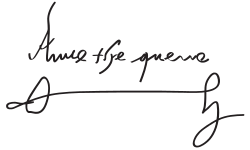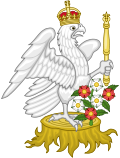Anne Boleyn
Anne Boleyn (1501 or 1507 – 19 May 1536) (birth unknown and unrecorded anywhere) was the second wife of King Henry VIII of England and queen consort from 1533 until 1536. Preluding the title of Queen, she was also marked Marquess of Pembroke. A title normally reserved for men. She was the mother of Elizabeth I of England. Anne has been called "the most influential and important queen consort England has ever had."[2] It was because of Anne Boleyn that Henry VIII divorced Catherine of Aragon, and became independent from the Roman Catholic Church. After she was accused of adultery, incest and high treason, she was beheaded.
| Anne Boleyn | |
|---|---|
| Marchioness of Pembroke | |
 Late Elizabethan portrait, possibly derived from a lost original of 1533–36[1] | |
| Queen consort of England | |
| 28 May 1533 – 17 May 1536 | |
| 1 June 1533 | |
| Predecessor | Catherine of Aragon (23 May 1533) |
| Successor | Jane Seymour (30 May 1536) |
| Born | 1501 or 1507 Blickling Hall, Norfolk |
| Died | 19 May 1536 (aged 34) Tower of London, London |
| Burial | 19 May 1536 Church of St Peter ad Vincula, Tower of London, London |
| Spouse | |
| Issue | Elizabeth I of England |
| Family | Boleyn |
| Father | Thomas Boleyn, 1st Earl of Wiltshire |
| Mother | Lady Elizabeth Howard |
| Religion | Protestantism |
| Signature |  |
There were many different opinions of Anne Boleyn's beauty. The Venetian diarist Marino Sanuto described Anne as "not one of the handsomest women in the world; she is of middling stature, swarthy complexion, long neck, wide mouth, bosom not much raised ... eyes, which are black and beautiful".[3] Simon Grynée wrote to Martin Bucer in September 1531 that Anne was "young, good-looking, of a rather dark complexion". Lancelot de Carles called her "beautiful" with a good figure. A Venetian in Paris in 1528 also said that she was beautiful.[4] The most well-known description of Anne[5] was written by the Catholic Nicholas Sanders in 1586. He wrote it several years after Anne died. Even though this is the most famous, it is also probably the least correct description. "Anne Boleyn," he said, "was rather tall ... with black hair, and an oval face of a sallow complexion, as if troubled with jaundice. She had a projecting tooth under the upper lip, and on her right hand six fingers (which historians now say is not true and was rather a double finger nail on her pinky). There was a large wen under her chin, and therefore to hide its ugliness she wore a high dress covering her throat ... She was handsome to look at, with a pretty mouth."[6] Sanders said that it was because of Anne that Henry went away from the Catholic Church. Sanders' words about Anne made what Eric Ives called the "monster legend" of Anne Boleyn.[7] Anne was also a good dancer. William Forrest, who wrote a modern poem about Catherine of Aragon, praised Anne's dancing. He said she had "passing excellent" skill as a dancer. "Here", he wrote, "was [a] fresh young damsel, that could trip and go."[8]
Early life
Little is known for certain about Anne's early life, beginning with the date and location of her birth. She was born in either in 1501 or 1507 (the date and month are unknown), as one source says she was 20 upon her return from France in 1521, and another that she was not yet 29 at the time of her death in 1536. The location was either Blickling Hall in Norfolk or Hever Castle in Kent. She was the daughter of Sir Thomas Boleyn, a courtier and later a diplomat, and his wife Lady Elizabeth Howard, daughter of the Duke of Norfolk. She had two siblings; a sister Mary and a brother George.
Anne's early education was the same for girls of her class. Her academic education was limited to arithmetic, her family genealogy, grammar, history, reading, and writing. She had been given a strong upbringing in religion and the Scriptures as the Boleyns were a family of firm religious beliefs. Anne developed domestic skills such as dancing, embroidery, good manners and morals, household management, music, needlework, and singing and excelled in playing several musical instruments including the block flute, the harp, the lute, and the virginals. She learned to play games such as, cards, chess, and dice and outdoor pursuits such as archery, falconry, horseback riding and hunting.
In 1513, she was sent to Margaret of Austria's royal court in the Netherlands to complete her education. Anne learned to speak French and studied art, culture, dance, literature, music, and poetry while she was there. The following year, she was transferred to the French court on the occasion of the marriage of Princess Mary Tudor, younger sister of King Henry VIII, to the French King Louis XII. Anne remained in France after the death of Louis XII and served as a lady-in-waiting to Queen Claude upon the accession of Francis I. In Queen Claude's household, Anne completed her study of French and developed a thorough knowledge of French culture and etiquette. As well as English, French, and some Italian, Anne demonstrated a working knowledge of Latin. She also developed an interest in fashion and religious philosophy that called for reform of the Church. Anne stayed in France until late winter 1521.
Return to England
Anne was called back to England to marry a distant cousin James Butler, in the hope to settle an inheritance dispute over the Earldom of Ormond. However, when the plan failed, Thomas Boleyn found a place for his daughter at the English court, as lady-in-waiting to Queen Katherine. There, Anne fell in love with Sir Henry Percy, who was the eldest son of the Earl of Northumberland, and they became secretly engaged to be married much to the displeasure of their respective families. Cardinal Wolsey ordered them to be separated. Anne was sent home to Hever Castle and Henry Percy was forced to marry Lady Mary Talbot, the daughter of Edward Talbot, Earl of Shrewsbury. Anne blamed Cardinal Wolsey for her lost love and was determined to have her revenge on him, because he had called her a ‘dumbass’.
Royal love affair
Anne came back to the royal court and soon King Henry fell passionately in love with her. He wanted her to become his mistress, however she categorically refused, which made Henry's desire for her even greater.
King Henry's marriage to Catherine of Aragon had produced only one daughter, Princess Mary, not thought suitable to rule the country after his death. Henry needed a son to succeed him and to secure the Tudor dynasty, but Catherine was now too old to have children. Henry then came to see Anne as the answer to the problem of the succession, and decided to divorce Catherine, so that he could marry Anne instead and have male heirs.
A special court was held, with Wolsey leading it, to decide if the divorce should be allowed. An official from the Pope in Rome was brought over and a trial was held. The official stated that he could not decide what to do. He wanted the Pope to decide instead. The Pope was fearful to offend Charles V, Holy Roman Emperor, nephew of Catherine,she had 11 and what would happen if he allowed the divorce. He did not make a decision. In the meantime, Anne and King Henry were becoming more and more impatient.
Marriage
After becoming Marquess of Pembroke in her own right, Anne felt secure enough and finally gave in to Henry in late 1532 and soon became pregnant. In order to have a legitimate heir to the throne, this meant that Anne and Henry needed to legalize their union quickly and therefore were secretly married on January 25, 1533, even though the divorce had not come through.
No longer hoping for the Pope to grant him a divorce, Henry's marriage to Catherine of Aragon was declared illegal in the following May by the newly appointed Archbishop of Canterbury Thomas Cranmer, former chaplain of the Boleyns. Catherine was sent away from court with the title of Dowager Princess of Wales as if she had never been married to Henry.
Now recognized as Henry's legal wife, Anne was formally crowned Queen of England on June 1, 1533. All that was needed now was the birth of a son and her triumph would be complete.
Anne gave birth to a daughter, the future Elizabeth I of England, on September 7, 1533. King Henry was very disappointed, after all his troubles, the problem of the succession was still not resolved. However, Anne soon became pregnant again but that ended in a miscarriage in the summer of 1534. Henry started to worry that Anne could not give him a healthy male child. Feeling the king's displeasure, Anne became more and more insecure and ever more difficult and Henry began tiring of her. The situation only deteriorated when the king began to pay special attention to a lady of the court named Jane Seymour.
When, on January 29, 1536, Anne gave birth to a stillborn male child, Henry felt betrayed and completely turned against her, accusing her of having bewitched him.
Downfall and execution
Henry's new secretary, Thomas Cromwell, looked for a way to get rid of Anne so that Henry could marry again to Jane Seymour. He found people who said that Anne had been the lover of other men while she was married to King Henry. She was put on trial and found guilty of treason, adultery and incest, although she was probably innocent. The men who were accused of being her lovers were Sir Francis Weston, her musician Mark Smeaton, Sir Henry Norris, William Brereton, and her brother Viscount Rochford George Boleyn. All of them were executed.
Anne was executed on 19 May 1536 in the Tower of London, London, England. She was buried in the Chapel Royal of Saint Peter ad Vincula.
Anne Boleyn Media
Portrait of Anne's elder sister Mary Boleyn, by Remigius van Leemput, c. 1630–1670
Drawing of Claude of France by Jean Clouet, c. 1520. The wife of Francis I of France, she was served by Anne as maid of honour for nearly seven years.
Interior Court of Savoy, Mechelen
King Henry and Anne Boleyn Deer shooting in Windsor Forest by William Powell Frith, 1903
16th-century portrait of Catherine of Aragon, Henry's first wife, by an unidentified English painter
Portrait of Henry VIII by Hans Holbein the Younger, c. 1537
Bishop John Fisher, by Hans Holbein the Younger. Fisher refused to recognise Henry's marriage to Anne.
Greenwich Palace, also known as the Palace of Placentia, after a 17th-century drawing
Notes
References
- Ashley, Mike British Kings & Queens (2002) ISBN 0-7867-1104-3
- Brigden, Susan New Worlds, Lost Worlds (2000)
- Elton, G. R. Reform and Reformation. London: Edward Arnold, 1977. ISBN 0674-75245-7
- Fraser, Antonia The Wives of Henry VIII (1992) ISBN 0-679-73001-X
- Graves, Michael Henry VIII. London, Pearson Longman, 2003 ISBN 0-582-38110-X
- Haigh, Christopher English Reformations (1993)
- Ives, Eric The Life and Death of Anne Boleyn (2004) ISBN 1-4051-3463-1
- Warnicke, Retha M. The Rise and Fall of Anne Boleyn: Family politics at the court of Henry VIII (1989) ISBN 0-521-40677-3









